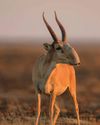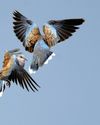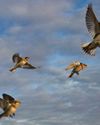
Animals come in a range of sizes. The smallest are from a group called Myxozoa, jellyfish-like parasites about one-hundredth of a millimeter long that are only visible under a microscope. Among vertebrates you would recognize with the naked eye, the smallest known to man is Paedophryne amauensis, a tiny frog that is just 8mm long.
How large can animals grow?
The heaviest beasts to ever walk the Earth were long-necked sauropod dinosaurs, known as titanosaurs. With a mass of about 50,000kg, titanosaurs weighed the same as 10 elephants and yet were still three times lighter than the largest species of all time, the blue whale, at 150 tonnes. Aquatic mammals often have a mass-to-volume ratio that matches the density of water, which provides neutral buoyancy and supports weights that can’t be reached on land due to size limits.
What limits total body size?
Bu hikaye BBC Wildlife dergisinin February 2022 sayısından alınmıştır.
Start your 7-day Magzter GOLD free trial to access thousands of curated premium stories, and 9,000+ magazines and newspapers.
Already a subscriber ? Giriş Yap
Bu hikaye BBC Wildlife dergisinin February 2022 sayısından alınmıştır.
Start your 7-day Magzter GOLD free trial to access thousands of curated premium stories, and 9,000+ magazines and newspapers.
Already a subscriber? Giriş Yap

SNAP-CHAT
Justin Gilligan on giant spider crabs and holding hands with an octopus

STEPPE CHANGE
Herds of saiga have returned to Kazakhstan, but there's a fine balance to tread

TREES FOR LIFE
Community is at the heart of conservation in the tropical forests of southern Belize

WHEN DOVES CRY
Turtle doves are now the UK's fastest declining bird species, but the RSPB is on a mission to save them

SURVIVAL OF THE CUTEST
We can't help being drawn to cute creatures, but our aesthetic preferences both help and hinder conservation

LIGHT ON THE NORTH
Spectacular images of Arctic foxes, reindeer and musk oxen reveal the wild beauty and diversity of Scandinavia

ROLLING IN THE DEEP
The super-sized crustacean that lives in the deepest, darkest ocean

LET'S GET TOGETHER
Clay licks deep in the Amazon explode in a riot of colour, with macaws the stars of the show

FEMALE OF THE SPECIES
To sponge or not to sponge? That is the question for the bottlenose dolphins (Tursiops aduncus) living in Shark Bay, Western Australia.

7 nature encounters for the month ahead
WITH NATURALIST AND AUTHOR BEN HOARE